
Art Exhibitions at Phillips Theological Seminary
In keeping with the purpose and mission, Phillips Theological Seminary presents four visual art exhibitions to the public each year. Visual art offers a unique way for people to build connections with each other and a platform to challenge individual assumptions about the world and ourselves. The annual exhibitions at Phillips offer a comprehensive look at some of the most important issues facing our society today, through the interpretation of professional artists. The exhibitions provide a space for visitors to learn about different cultures, histories, and perspectives, and to reflect on their own sense of belonging and identity. The exhibitions also offer a platform for dialogue and action, and they encourage visitors to consider how they can contribute to a more just and equitable world, in keeping with the teachings of Jesus Christ.
- The winter exhibition connects with the topic for the Remind & Renew conference.
- The spring exhibition continues the tradition of an exhibit as part of the annual Tulsa Race Massacre Lecture.
- The summer exhibition opens for new student orientation and is dedicated to the importance of diversity, equity, inclusion and belonging.
- The fall exhibition celebrates the rich and diverse cultures of the Indigenous peoples of North America.
Artist Submissions
Phillips invites local and regional artists to submit their artworks for a solo visual art exhibition at the seminary. Click the box for more information and a submission form.
Now on View


Something New, Black Birds (2121) by Halim A. Flowers
April 29, 2024 - July 14, 2024. Public viewing from 9 a.m. to 5 p.m. Monday through Friday.
SOMETHING NEW, BLACK BIRDS (2121) is a collection of twenty-one original paintings created by the visual artist Halim A. Flowers. The works were inspired by the painter's researching the tragedy that took place in Tulsa, Oklahoma on the evening of May 31, 1921. Upon visiting the city, and connecting viscerally with the land that was once held sacred by the indigenous people before colonization, the elasticity of his imagination expanded after learning more about the local histories encompassing all cultural denominations that shared the area.
Halim A. Flowers is represented by Nicole Longnecker Gallery. To view all the pieces in the show and to purchase, visit this link: Something New, Black Birds (2121) | Nicole Longnecker Gallery.
Read More About the Exhibition
Upon returning to his studio from his trip to Tulsa this year, and after deep meditation, prayer, and fasting, Flowers was guided by his intuitive spirit to allow a visual language to flow through him that would imagine what the city of Tulsa – in particular its Greenwood area – would look like in the year of 2121, two hundred years after the historic fatal events.
“In order to not repeat the past, we must use our collective imagination capital now, in order to alchemize a more loving and genuinely equitable future,” Flowers wrote. “The human family fails collectively, for its lack of vision. Therefore, I have initiated a success for the city holistically, by creating a unique visual language aesthetic, for its people to have the audacity to love and dream together across generic divisive constructs.
“Soul planes dropping bombs of love, mass graves resurrecting in joy, and the five civilized vibes are just a few of the visual poetries that will be illustrated in this collection. I believe that love is the vaccine to cure the spiritual hearts from the illness of indifference. It is through this vision and prayer that this body of work can bring the city of Tulsa together in radical love that will transcend all superficial barriers that serve to fracture the strong and resilient people of this industrious city.”
“We are honored to work with Phillips Theological Seminary on the Tulsa Race Massacre Lecture Series through art.” said gallery owner Nicole Longnecker. “The choice of Halim Flowers for this important solo exhibit was driven by the clear message in his work to bring communities together and illuminate topics that generate societal connections through love.”
Artist Biography
Halim A. Flowers (b. 1980, Washington, DC) is an activist working between the visual and performing arts through a wide range of mediums including painting, sound, fashion, and performance. At age 16, he was arrested and sentenced to life in prison. At 38, after 22 years behind bars, he was released after successfully petitioning for resentencing. Art was Halim’s road to resilience and redemption.
While in prison, Halim became a memoirist and poet with an irrepressible drive to make meaning out of darkness. Liberated through self-expression, he wrote and published 11 non-fiction works about the causes and consequences of the American prison system. He mentored incarcerated youths through D.C.’s Young Men Emerging program and took courses at Georgetown University through its Prisons and Justice Initiative. Halim’s experiences were captured in the Emmy award-winning documentary, Thug Life In DC. It’s powerful evidence of the persistence of human creativity in the most inhumane of circumstances. He refused to be rendered invisible.
In the aftermath of his incarceration, Halim became a husband and a father. It was his wife, Lauren McKinney, who encouraged him to pick up a paintbrush. Halim has created a spectrum of colorful, politically charged paintings to reclaim the individuality and agency that gets broken down in carceral spaces. He keeps an aura of kindness and positivity, choosing to send a message of love even when the subject is serious.
Halim’s work has been exhibited at the MoMA PS1 and the National Arts Club in New York City. He is the recipient of numerous honors, including Halcyon Arts Lab and Echoing Green fellowships. He is a sought-after speaker and has been featured on panels at universities and conferences around the country. In 2022 he launched his own streetwear clothing brand, debuted at New York Fashion Week and released his first album of rap music called “Ultracrepidarian.“
Halim Flowers’ body of work is a visceral, visual embodiment about the ambition of racial justice, prison reform, financial literacy, and transcending adversity suggesting a sense of renewal, positivity and hope.

Halim Flowers
Healing Park(2121), 2024
acrylic and oil sticks on canvas
40 x 30 in

Halim Flowers
Love Lends Wings (2121), 2024
acrylic and oil sticks on canvas
40 x 30 in

Halim Flowers
Blackbirds, Something New, 2024
acrylic and oil sticks on canvas
40 x 30 in



Past Exhibitions
Veins of Oklahoma
Veins of Oklahoma by Taylor Painter-Wolfe was exhibited at Phillips Theological Seminary from January 24, 2024 to April 5, 2024.
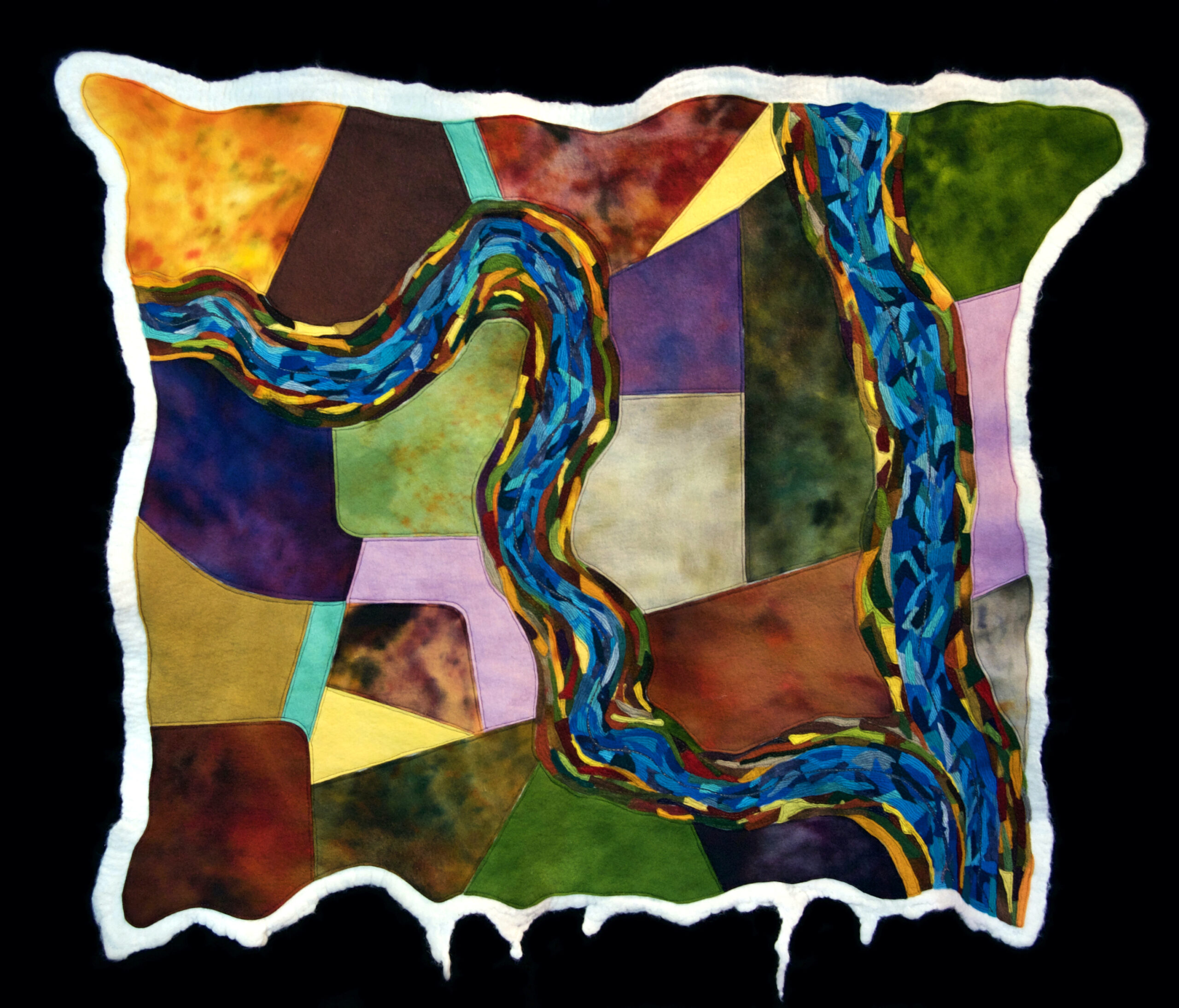
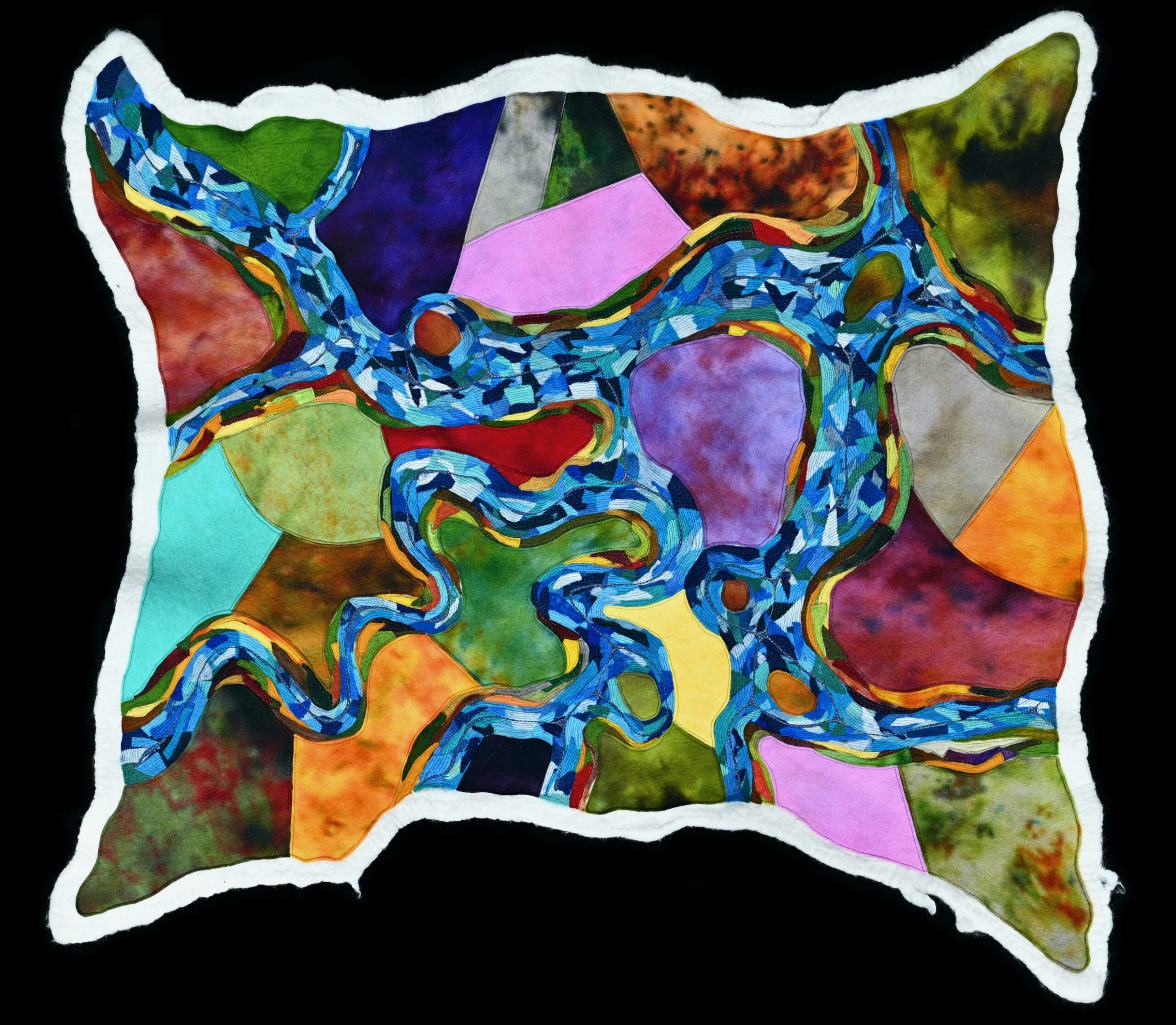
Artist Biography
Taylor Painter-Wolfe is a fiber artist and art teacher from Tulsa, Oklahoma. She majored in fiber art at the Kansas City Art Institute where she first learned how to make and dye felted wool. She graduated with a Bachelor of Fine Arts in 2003 and later attended The University of Washington where she earned a Master of Education in early childhood special education. In 2011, she returned to Tulsa where she has taught special education, preschool, and art in Tulsa Public Schools. Taylor now divides her time between making and showing her own work and teaching art classes and workshops to children and adults in various galleries, arts organizations, and schools throughout Oklahoma. She creates abstract landscapes made of felted wool using many traditional fiber art techniques. Her work is inspired by aerial photographs, satellite images, and her own photography of natural environments.
Some of Taylor’s most notable exhibitions and projects are “Don’t Look Down,” a 2017 solo exhibition at The Kansas City Artist Coalition, “Green Country Air,” a year-long installation at the Tulsa International Airport in 2018, she was chosen as the 2019 Holland Hall ARTworks artist, and as the designer and creator of the 2021 Winter Festival pin for The Philbrook Museum of Art. In 2022 she received a Tulsa Creates Together grant through Living Arts Tulsa and in 2023 she had an installation of her work up in The Oklahoma State Capitol in Oklahoma City and a solo show entitled, “Meander,” at Liggett Studios. Her work also appears regularly in group shows locally and regionally.
Artist Statement
My current work is focused in part on simplifying my compositions and experimenting with different dyeing and felting techniques. In making the felt for these pieces, my use of dye has become looser and more spontaneous, which creates interesting and unpredictable textures on the material. My aim is to emulate textures found in natural landscapes like those that can be seen on large swaths of land from a bird’s eye view as well as tiny areas of rich texture found on rocks and trees. Focusing on this element of the work allows for increased open space, making compositions more gestural and less crowded. By doing this, I hope to evoke feelings frequently experienced in open spaces in nature where visual perspective can often give way to spiritual and emotional insight.
My latest pieces are inspired by satellite images of various rivers throughout Oklahoma. For me, rivers make for a very compelling compositional device with endless inspiration to be found in the way they wind through and carve up a landscape. With this work I have been experimenting with new techniques to evoke the feeling of moving water and differentiate the texture of the water from the texture of the land. The river is a visual reference taken from reality which then allows me to take more liberties in representing the surrounding landscape in an abstract way. Viewed from above, there are shapes and colors that are not naturally occurring, the land bares the fingerprint of human use whereas the river appears wilder and more untouched. In this work, I am exploring the tension between the natural form and beauty of the river and the stark geometry and patterns imprinted upon the land by humans.
~Taylor Painter-Wolfe
Indigenous Visions: A Mvskoke Visual Narrative of Resilience
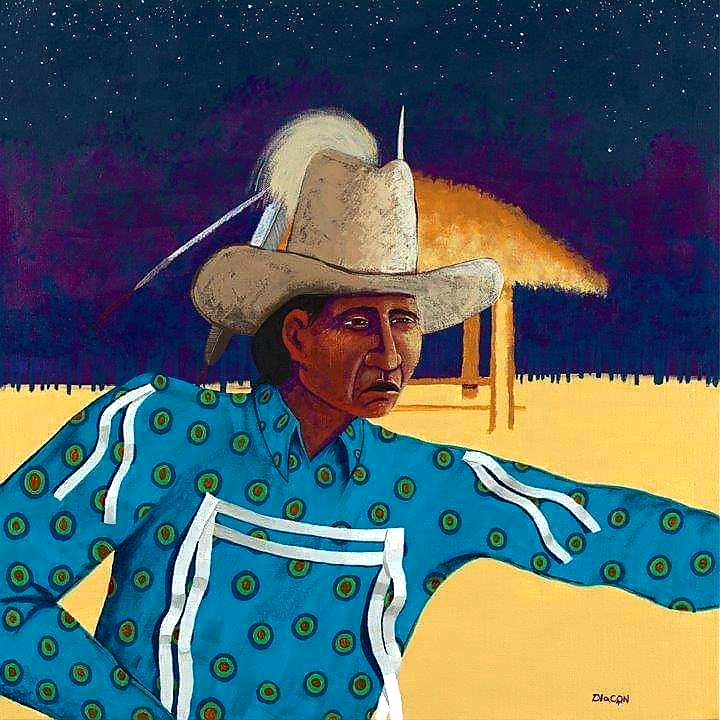
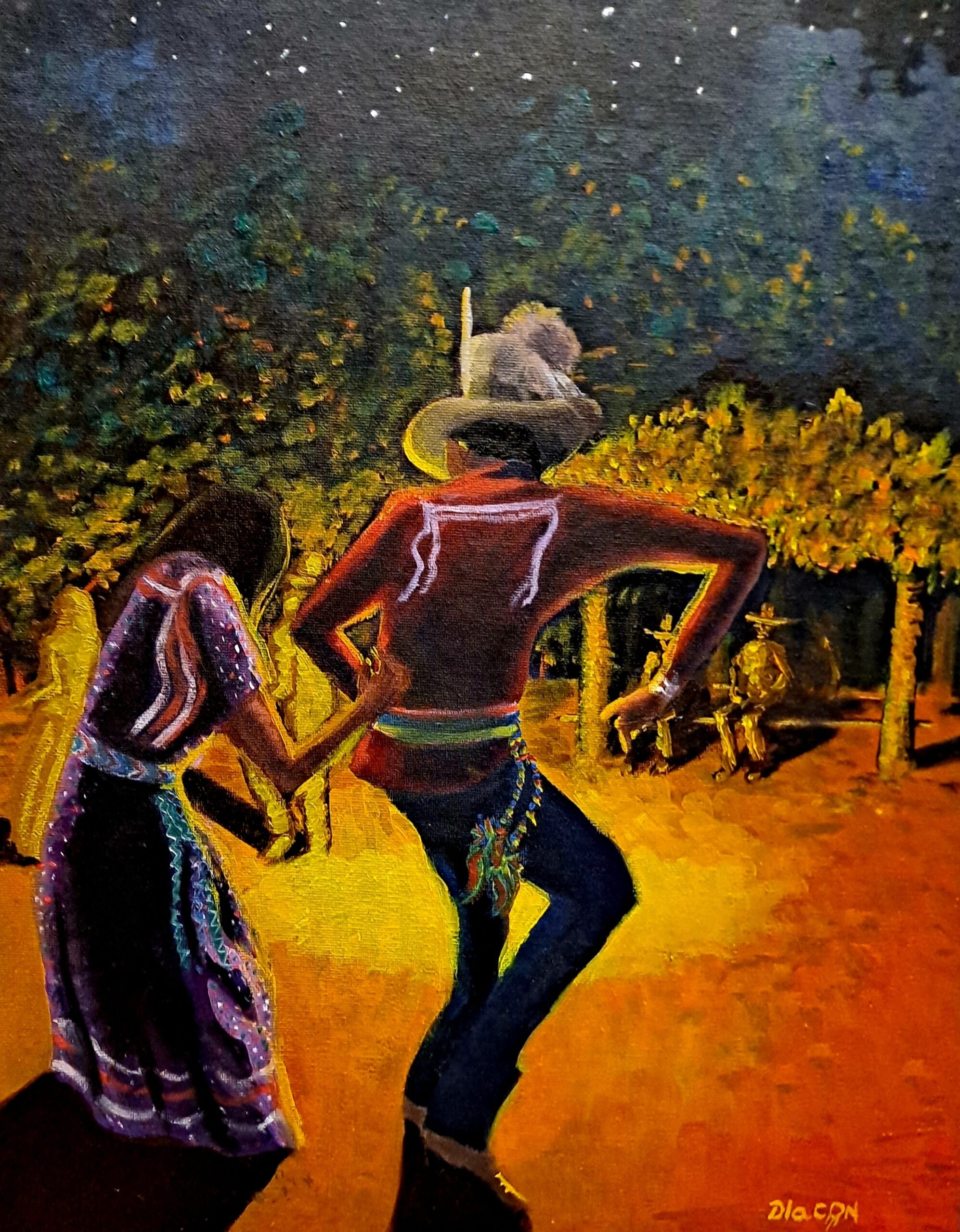
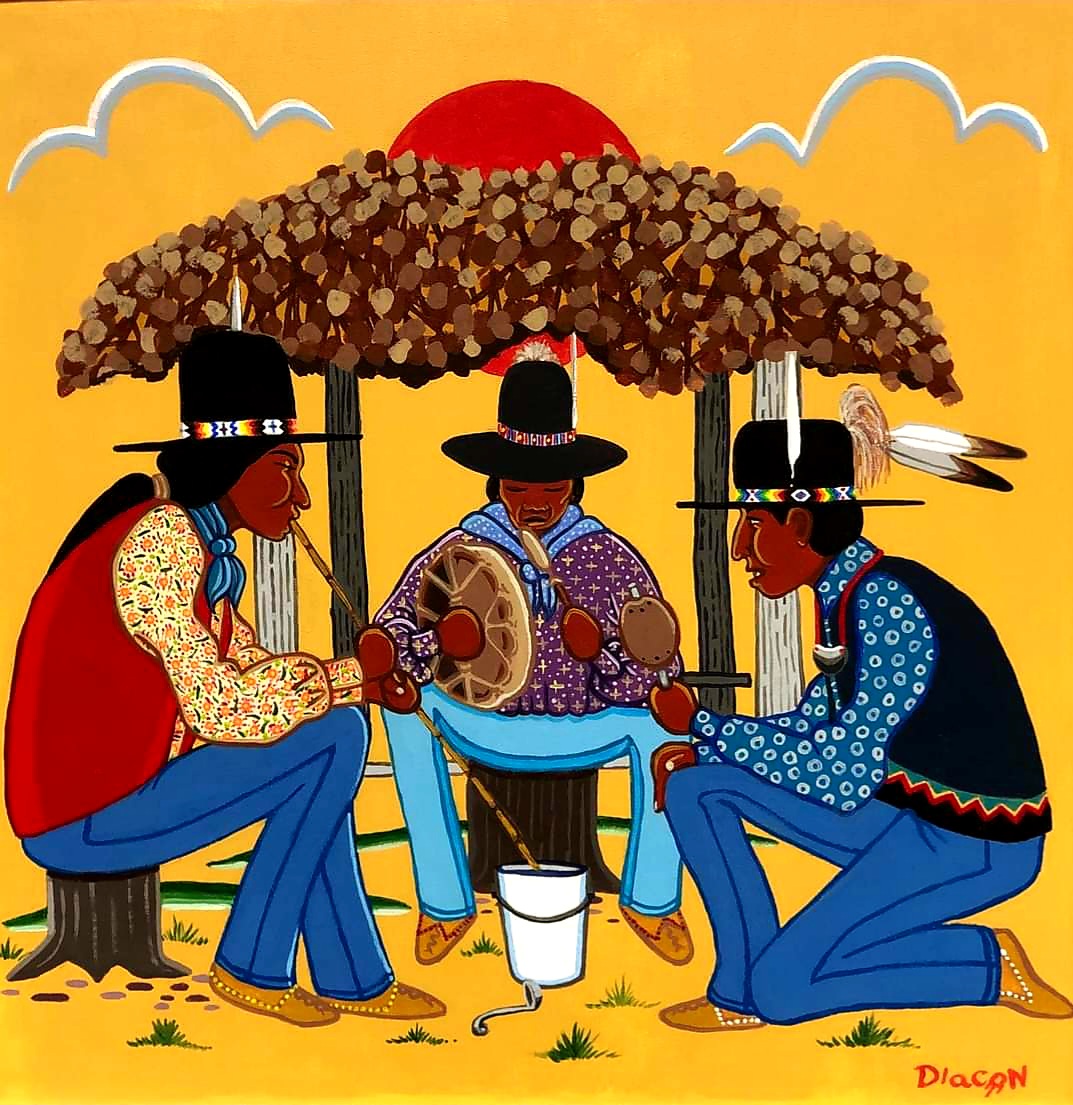
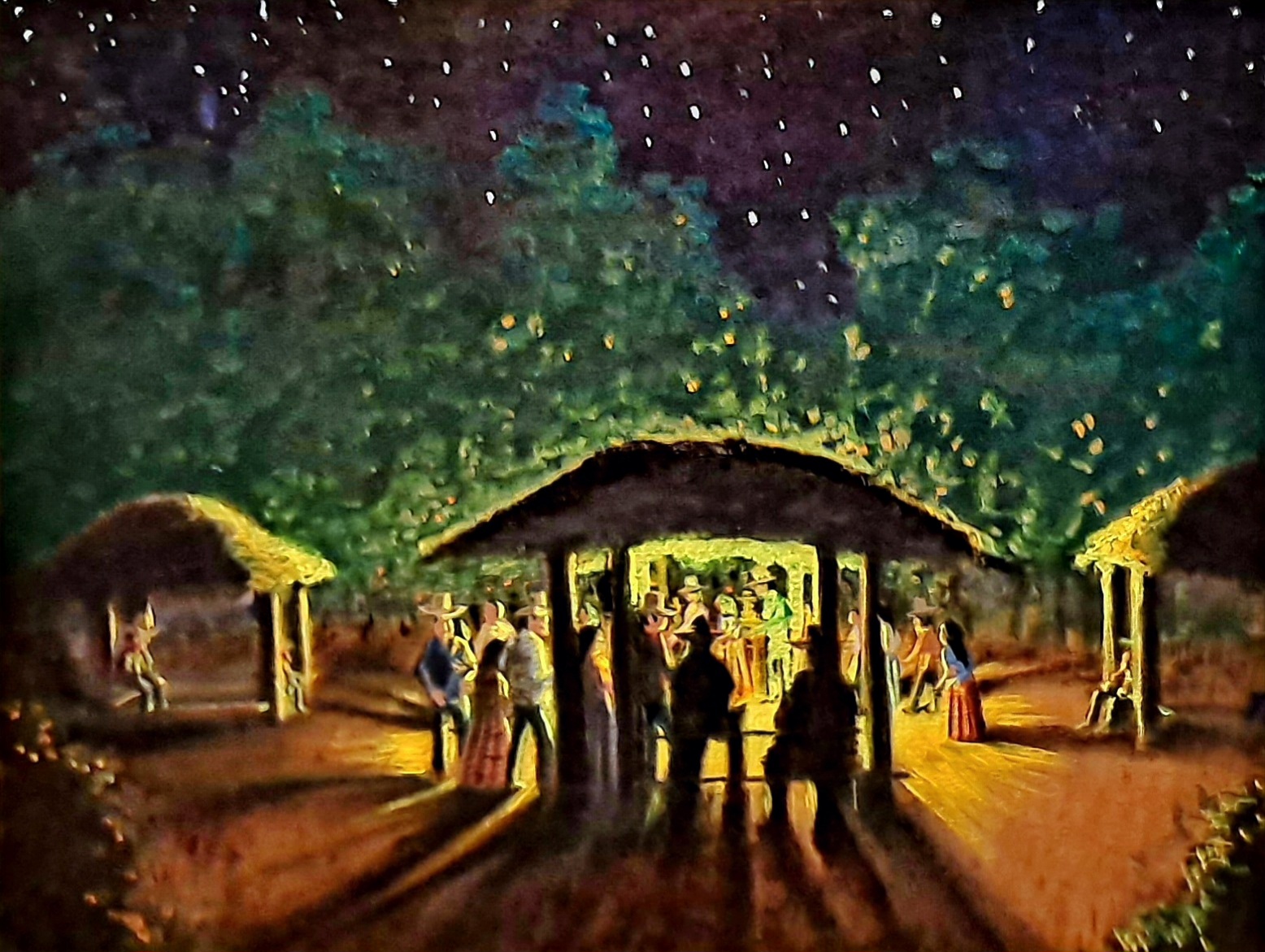
Indigenous Visions: A Mvskoke Visual Narrative of Self was exhibited at Phillips Theological Seminary from November 6, 2023 to January 5, 2024.
Artist Biography
Artist Johnnie Diacon is Muscogee (Mvskoke), Thlopthlocco Tribal Town (Raprakko Etvlwa), and Deer Clan (Ecovlke) and has nearly 40 years of experience in fine art. He is a graduate of both Bacone College and the Institute of American Indian Arts (IAIA) and currently lives on the Muscogee Reservation in Tulsa, Oklahoma.
Johnnie works in many different mediums; acrylic, oil, watercolors, 3D assemblages, and beadwork. He has created sequential art for graphic novels such as Tales of the Mighty Code Talkers Volume 1 and Chilocco Indian School: A Generational Story. His work is in various private and public collections around the globe and can also be seen in numerous publications, book covers, videos, and on the sets of FX’s Reservation Dogs.
Artist Statement
In the majority of my works I focus on my people, the Mvskoke, commonly referred to as Creek. I often depict my people as they are today in the 21st century, practicing our religious ceremonies as they have for thousands of years. Aside from dress, the ceremonies remain practically unchanged since the beginning when the Creator gave them to us. Our culture is a strong one that has endured many outside influences, many of which were quite brutal in their attempts to change or eliminate them. It is from this that I draw inspiration for my work. I try to depict my people in an honest and humble manner. For most non-Native people who have little to no experience with the Native People, and whose knowledge is based on Hollywood stereotypes as to what Indian culture is, I try to break this chain of misinformation. The lifeway of the Mvskoke is much different than, for example, the original people of the desert, plains, prairies, and coastal regions of this land. Our ceremonial dress, dances, and songs are not like the ones seen and heard at modern intertribal powwows, so images of the Mvskoke ceremonial ways do not always fit non-natives’ preconceived notions of what being “Indian” means. In my art I often attempt to break down cultural stereotypes by exploring the traditional stories and life ways of the Mvskoke and presenting them to the world in an artistic manner that translates in a way that is relevant and can be appreciated by both native and non-native alike. I hope this will nurture an understanding between cultures.
~Johnnie Diacon
Ghosted Portraits: The Invisible Narratives of Self
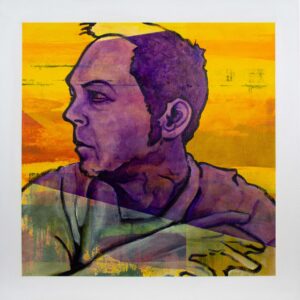
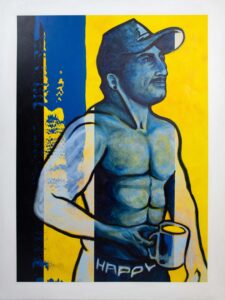
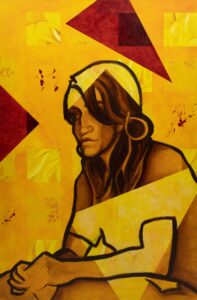
Ghosted Portraits: The Invisible Narratives of Self by Trace Logan was exhibited at Phillips Theological Seminary from August 21, 2023 to October 20, 2023.
What does it mean to be seen? How do we express our true selves in a world that often expects us to fit into certain molds? How can art help us explore these questions and challenge our assumptions?
These are some of the questions that inspire Trace Logan, a Philadelphia-born artist who currently lives in Oklahoma City. Trace works with various mediums, such as acrylic, digital art, photography, and collage, to create stunning abstract portraits that reveal the invisible narratives of self. He is also a proud member of the LGBTQ community and a passionate advocate for social justice.
Ghosted Portraits: The Invisible Narratives of Self, featured portraits of members of Trace’s community, mostly LGBTQ individuals, who have agreed to share their stories and perspectives through art. Trace uses abstraction to create a visual contrast between personal identity and public persona. He combines elements of texture, color, and movement with realistic facial features to create a dynamic and expressive representation of each subject. The result is a captivating and thought-provoking collection of artworks that invite viewers to reflect on their own identities and perceptions.
Artist Biography
Trace Logan was born and raised in Philadelphia but has lived in Oklahoma City for many years. A lifelong artist with an early education in Graphic Design and Commercial Art, Logan works in
various mediums, including acrylic, digital art, photography, and collage. He became interested in abstraction ten years ago while taking an art class.
Logan has shown artwork at the Equality Center in Tulsa, several Oklahoma City locations, and Alva at the Graceful Arts Center. He is currently pursuing a master’s degree in counseling at Oklahoma State University and hopes to incorporate art into the therapy process.
Artist Statement
All art is a form of communication, but abstraction is art stripped down and simplified to its most basic elements. Essentially it is the alphabet of visual art, and just as nothing is communicated in writing without combinations of the 26 letters of the alphabet, nothing is expressed in art without color, line, shape, texture, space, rhythm, harmony, contrast, and balance. Abstraction avoids the contamination of culturally loaded objects.
This project combines my interests in sociology and psychology, my personal beliefs and perspective, and art by merging portraits of members of my community with elements of abstraction such as texture, color, and movement. I have, informally, called the artwork ghosted portraits because of the sections that are not filled in, which represent the aspects of others that are unknown or unseen. But that is only part of the story.
These paintings are a visual representation of the contrast between personal identity and public persona. How we identify and what we believe about ourselves may not be how others perceive us. Those misperceptions may be harmful, beneficial, or inconsequential, but the area where personal identity collides with public perception can be rife with highly nuanced, multi-layered conflict. I prefer my conflicts to be in contrasting colors. What elements are visible (public identity) vs. obscured (private identity) and how to tell both stories is what drives my art practice.
~Trace Logan
The Language of Our Souls: The Visual Poetry of Harvey Johnson
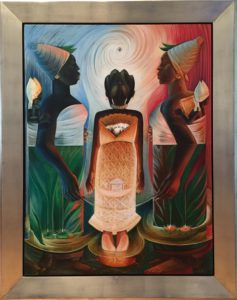
Phillips Theological Seminary is presented the 2023 Race Massacre Lectureship and Art Exhibition featuring the art of Harvey Johnson on its Tulsa, Okla. campus, April 25-May 18 from 9 a.m.–5 p.m. with an opening reception April 23 from 5–9 p.m.. The show also featured works by John Biggers, Delita Martin, and Kermit Oliver.
Johnson came to Houston from Port Arthur to study art at Texas Southern University under world- renowned artist, sculptor, and teacher, John Biggers, who founded the school’s art program in 1949. Johnson completed his undergraduate degree at TSU and went on to get his MFA at Washington State University. He returned two years later to teach art at TSU for 34 years before retiring in 2007.
Click here to watch a video of Harvey Johnson speaking about his work.
Artist Statement
“Walk Together Children”
Dedicated to all young people and the journey – they must endure for the survival of this planet.
I am a seed from a mother and father of the Southern soil of Texas and a child of African roots. As I emerged from the oil fields of Port Arthur, Texas into the urban setting of Houston, Texas, I discovered how I fit into the rich Texas quilted pattern of cultural diversity. This diversity, this contrast of Native, African, Mexican, Caucasian, and Asian peoples have all helped to create a Texas “ aesthetic “ , and contributes to a rich vision for Texas posterity. My poetry speaks of African spirituals or what continues to be referred to as “Negro Spirituals.”1 A young African student at Key Middle School in Houston, Texas, stated that spirituals are “secret messages in song about God.” It is the most profound and sophisticated meaning of these songs I have ever read or heard. I feel African spirituals and nature have given us a complex meaning of the sacred laws governing the order of the universe in its ever evolving cycles of life and death and life. An example of this can be heard in the spiritual, “We are Climbing Jacob’s Ladder.” Spirituals and nature embraces healing and renewal.
My poetry tries to express a continuous journey of healing – healing generated within me with the assistance of Spirit, African ancestors, a parental matriarch, and elders. They all provided access allowing for the discovery of personal identity, purpose and meaning of my existence as a part of what I call a triple “middle passage.”
The first middle passage is the journey of an immaculate conception as we come into this life through the boat of heaven that is the sacred womb of all mothers. For months, our mothers of “The Father and The Son” navigate us in her holy sanctuary through the many fires of life as we finally emerge into the light. Life is not about safety however and some of us do not make it. I feel that some of us return to that unfrozen reality, the invisible. Our mother’s heartbeat to us, like the rhythmic beat of the drum, is the “Word,” the first communication to us of the articulation of language and civilization.
The second middle passage echoes these words from a spiritual, “Ev’-ry-bo-dy talk-in’ ‘bout heab’n aint goin’ dere…” This speaks to the transatlantic slave trade and its ramifications to this present day, a holocaust of unmerciful human pillage and destruction. I hope my poetry expresses a compassion, which we all must have, for other people whose grief is just as deep about their holocaust. A great American author said, “History is not the past…history is the present.” And I will add that history is also the future.
The third middle passage is about human transformation, not only ultimately from body to spirit literally but, transforming human and environmental abuse into positive spirituality and humaneness. I hope my poetry stimulate consciousness to awaken each of us to the purpose for which we came into this world or were born into this life.
We live in an environment where myths about ourselves have become the norm, have become realities. These myths are used as a frame of reference for our very existence. We have become prisoners to a history of our own making. I feel that poetry encourages an awakening of our senses by expressing how the language of nature puts an end to all human myths and forces us back to reality. Earth, wind, fire, water, minerals, and animals speak to us, trying to bring us closer together. Nature forces us to see that many of our fears and insecurities come from the inner unsolved struggles we are having about ourselves, which many times we transfer to others. As I share my journey with you, I hope that you focus on your own journey.
I feel good about the energy of our youth. They seem to be aware that jobs and careers do not definite success and the spirit of their being. “Your ability to see is always a delusion of what you see, and what you see, is usually a translation of your own limitation at seeing until you are taught how to see…it’s an introduction into that area of silence where meaning exist independently of human extortion and it is an introduction into that area of human experience where it is possible at least to reconstruct one’s history going beyond one’s birth into a timeless moment where one can see one’s self as much older as one look in order to be able to understand why one occurred in this particular time and what for.” –Malidoma Some’, African Shaman
Poetry is one of many visionary expressions that can inspire, to help us stay in touch with the silent language of our souls in keeping with the rhythmic balance and harmony of nature as it moves toward a greater scheme of creation. You may wonder whether this is all there is to being here in this life. It is if this is the limitation of your thinking, feelings, and emotions. Nature is the key to teaching us about unlimited doorways connecting us to a cosmic conception and journey. Our young people have the opportunity to create new worlds of spiritual values which can define us as true human beings.
In the spirit of the Negro Spiritual, let us all “Walk Together Children.” I don’t know anything else more important. Harvey Johnson
1 Poetry in this context refers to visual, musical, dance, literary, and theatric expressions that address the what, where, when, how, and why of human existence. It replaces the term “art” for a deeper meaning of the human journey.
Included Works
The Welcoming Table
Harvey Johnson, 2021
Acrylic and oil wash on canvas
Walk Together Children
Harvey Johnson, 2009
Acrylic and oil wash on canvas
Eulogy, 1921 (Tulsa)
Harvey Johnson, 2022
Conte crayon on paper
Elegy: 1883-Present
Harvey Johnson, 2022
Conte crayon on paper
Wash House—Morning Star
Harvey Johnson, 2006—2010
Acrylic and oil wash on canvas
The Greatest Good
Harvey Johnson, 2000
Conte crayon on paper
Mirror Mirror
Delita Martin, 2020
Gelatin printing, conte, acrylic, hand stitching, fabric
Daughter of the Eternal Light
Harvey Johnson, 2003
Acrylic and oil wash on canvas
Do This in Remembrance of Me
Harvey Johnson, 2010
Conte crayon on paper
Humble Yo’self, De Bell Done Ring
Harvey Johnson, 2011
Acrylic and oil wash on canvas
Walk with Me
Delita Martin, 2016
Gelatin printing, conte, acrylic, hand stitching, fabric
Three Kings (Gammadion)
Harvey Johnson, 2014
Acrylic and oil wash on canvas
Our Grandmother
John Biggers, 1992
Acrylic and oil wash on canvas
Disparity, Until the Morning Comes
Harvey Johnson, 2011
Conte crayon on paper
We Build Our Temples to Tomorrow
Harvey Johnson, 2011
Acrylic and oil wash on canvas
Glory, Glory
Harvey Johnson, 2000
Acrylic and oil wash on canvas
Blessed Are the Fruit of the Womb
Harvey Johnson, 2019
Conte Crayon on paper
A City Called Heaven (Upper Room)
Harvey Johnson, 2016
Acrylic and oil wash on canvas
Wisdom Knot
Harvey Johnson, 2007—2013
Acrylic and oil wash on canvas
I See Mama
Harvey Johnson, 2009
Conte crayon on paper
Father and Son Series
John Biggers, 1964
Ink on paper
How I Got Over
John Biggers, 1987
Acrylic and oil wash on canvas
Burnt Church
Kermit Oliver, 1965
Lacquer and Japanese oil glaze on wood
Bloodline
Delita Martin, 2023
Relief printing, decorative paper, hand stitching
Sometimes My Blues Change Colors 1 of 5 V.E.
Delita Martin, 2023
Relief printing, decorative paper, hand stitching
My Sisters Keeper
Delita Martin, 2023
Relief printing, decorative paper, hand stitching

